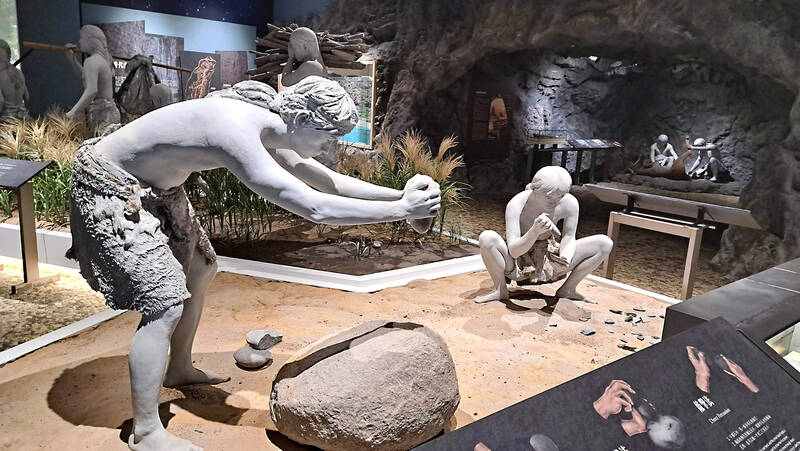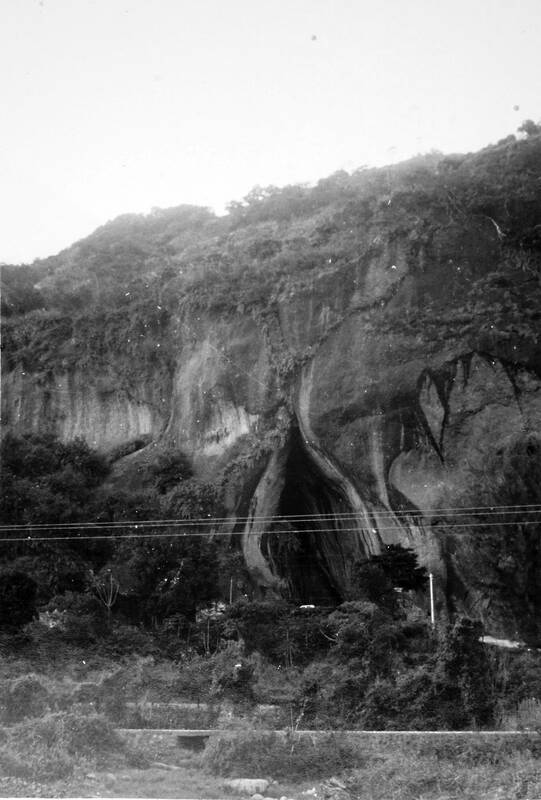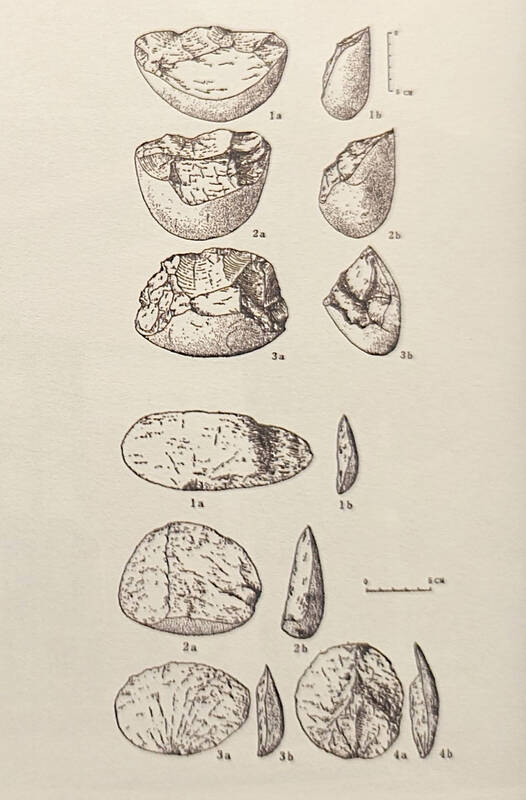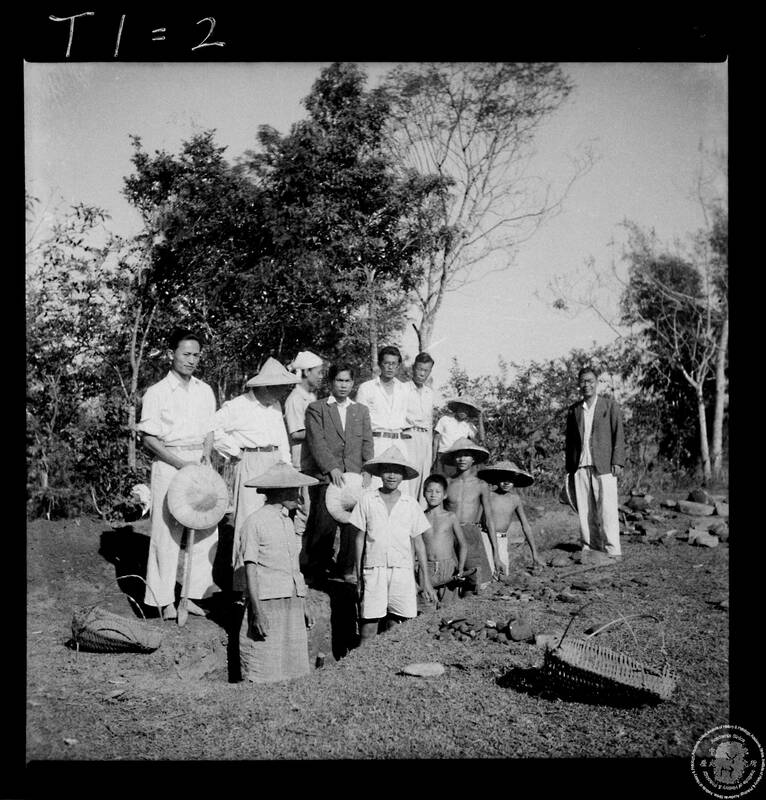Jan. 6 to Jan. 12
Perhaps hoping to gain the blessing of the stone-age hunter-gatherers that dwelt along the east coast 30,000 years ago, visitors to the Baxian Caves (八仙洞) during the 1970s would grab a handful of soil to bring home.
In January 1969, the nation was captivated by the excavation of pre-ceramic artifacts and other traces of human habitation in several caves atop a sea cliff in Taitung County. The majority of the unearthed objects were single-faced, unpolished flake tools fashioned from natural pebbles collected by the shore. While archaeologists had found plenty of neolithic (7,000 BC to 1,700 BC) remains in Taiwan, this was the first time a paleolithic (2.5 million to 11,000 years ago) culture was discovered.

Photo: Huang Ming-tang, Taipei Times
After the first excavations, Lee Chi (李濟), then director of Academia Sinica’s Institute of History and Philology, visited the site on Jan. 8 and named the culture “Changpinian” (長濱文化) after the local township, although most English sources today use “Changbin Culture.”
Since the timeline fit with the last ice age, when the Taiwan Strait was traversable by foot, lead archaeologist Sung Wen-hsun (宋文薰) surmised that these people arrived in pursuit of migrating animals from China. Due to similar sites being found in the Philippines, Vietnam and Indonesia, some also believe that they arrived via sea from Southeast Asia. But due to a lack of human remains, the truth remains murky.
The caves were popular; several thousand years after the first inhabitants left, neolithic farmers arrived and left a trove of artifacts. Recent excavations have shown that iron age peoples also visited, although they did not reside there.

Photo courtesy of Taiwan Cultural Memory Bank
OLDEST HUMANS
Once underwater, the Baxian Caves were formed by sea erosion and pushed upward by tectonic uplift. During the Japanese colonial era, several shrines and altars were set up in several of the caverns, with the largest one in Chaoyin Cave (潮音洞).
On March 4, 1968, National Taiwan University (NTU) geology professor Lin Chao-chi (林朝棨) visited the caves to investigate the soil and rock layers, unexpectedly finding traces of neolithic human habitation. He also found traces of reddish clay, which suggested the existence of older layers underneath, writes Sung in Changpinian: A newly discovered preceramic culture from the agglomerate caves on the east coast of Taiwan (長濱文化 : 臺灣首次發現的先陶文化).

Photo courtesy of National Central Library
Sung happened to be in Taitung at that time, preparing to excavate the megalithic Qilin Culture (麒麟文化). Lin contacted him, and after work on the Qilin Culture was done, Sung brought the entire team to the Baxian Caves on March 27. They agreed it was worth further exploration and requested the county government to grant it protected status, since people were still using the caves. These inhabitants had dug up about three meters of earth in Chaoyin Cave, but fortunately a patch by the entrance remained intact.
Funds finally came down from NTU by the end of the year, and the duo arrived in Taitung on Dec. 26 and began digging, finding by Dec. 30 “irrefutable evidence” of a pre-ceramic cultural layer beneath the reddish clay. As there were no phones on site, Sung rushed to Changbin town and called Lee Chi, whom he refers to as “Taiwan’s leading authority in anthropological archaeology.” Lee arrived with two other experts, Shih Chang-ju (石璋如) and Li Yih-yuan (李亦園), and confirmed that this was the nation’s oldest human discovery.
TWO LAYERS

Photo courtesy of Academia Sinica Institute of History and Philology
The story was a media sensation, with United Daily News reporters being the first to arrive on New Year’s Day. Reports continued throughout the the entire month as the public was enthralled by the discovery, writes Tseng Yu-hsuan (曾于宣) for the National Museum of Prehistory. In addition, tourists started pouring in.
By Jan. 4, a substantial amount of artifacts and traces of human habitation such as ash and food waste were found in three of the caves. Curiously, nothing was found in the deep layer of red soil, indicating that there was at least a 2,000-year gap between the two cultures. One theory states that the caves became uninhabitable after sea levels rose as the glaciers retreated, and were only used again after re-emerging through tectonic activity.
A second excavation took place later that month, focusing on Chaoyin Cave, where the majority of the tools were found. Sung and Lin carried out a total of five digs in seven caves that year, unearthing more than 3,000 paleolithic objects.
The neolithic layer included refined stone hoes, knives, sickles, spears, arrowheads, as well as evidence of pottery and weaving technology. The inhabitants lived there approximately 3,500 to 1,500 years ago were mainly farmers and hunters. Aside from the absence of metal, their lifestyle was similar to the indigenous Taiwanese before modernization, Sung writes.
By contrast, the paleolithic layer yielded no farming tools or arrows, nor pottery or weaving. The team found only crude, mostly flaked stone, as well as bone and antler tools.
A CLEARER PICTURE
After Lin and Sung’s efforts, no further investigation was made into the site until 2008, when National Tsing Hua University’s Tsang Chen-hwa (臧振華) excavated 16 more caves, one rock shelter and one open-air terrace. Tsang was able to offer a clearer picture of human activity, writing in a 2017 publication that the first inhabitants arrived about 30,000 years ago, staying for about 15,000 years. These first peoples consumed little from the sea — subsisting mainly on boar and deer — even though they lived next to it.
Another group stayed there about 6,000 to 4,800 years ago, now possessing the ability to polish and refine their tools. Their lifestyle was similar to the previous group, but they engaged in fishing and collected shellfish. They were relatively few in number and mostly stayed by the shore, Tsang writes, and over the years archaeologists unearthed similar sites along the coast.
The neolithic peoples made the caves their home between 3,500 and 2,000 years ago, and Tsang also found iron age artifacts, including metal jewelry and agate beads from later visitors.
Tsang writes that the exact origin of the Chanbin Culture remains disputed, as similar sites have been found in southern China, the Philippines and Vietnam. In addition to the original theory, he suggests that they could also have been part of the first wave of humans who left Africa and dispersed toward Asia about 60,000 years ago, passing through Southeast Asia and onward to Taiwan, China and even Japan.
Taiwan in Time, a column about Taiwan’s history that is published every Sunday, spotlights important or interesting events around the nation that either have anniversaries this week or are tied to current events.

This month the government ordered a one-year block of Xiaohongshu (小紅書) or Rednote, a Chinese social media platform with more than 3 million users in Taiwan. The government pointed to widespread fraud activity on the platform, along with cybersecurity failures. Officials said that they had reached out to the company and asked it to change. However, they received no response. The pro-China parties, the Chinese Nationalist Party (KMT) and Taiwan People’s Party (TPP), immediately swung into action, denouncing the ban as an attack on free speech. This “free speech” claim was then echoed by the People’s Republic of China (PRC),

Exceptions to the rule are sometimes revealing. For a brief few years, there was an emerging ideological split between the Democratic Progressive Party (DPP) and Chinese Nationalist Party (KMT) that appeared to be pushing the DPP in a direction that would be considered more liberal, and the KMT more conservative. In the previous column, “The KMT-DPP’s bureaucrat-led developmental state” (Dec. 11, page 12), we examined how Taiwan’s democratic system developed, and how both the two main parties largely accepted a similar consensus on how Taiwan should be run domestically and did not split along the left-right lines more familiar in

Specialty sandwiches loaded with the contents of an entire charcuterie board, overflowing with sauces, creams and all manner of creative add-ons, is perhaps one of the biggest global food trends of this year. From London to New York, lines form down the block for mortadella, burrata, pistachio and more stuffed between slices of fresh sourdough, rye or focaccia. To try the trend in Taipei, Munchies Mafia is for sure the spot — could this be the best sandwich in town? Carlos from Spain and Sergio from Mexico opened this spot just seven months ago. The two met working in the

Many people in Taiwan first learned about universal basic income (UBI) — the idea that the government should provide regular, no-strings-attached payments to each citizen — in 2019. While seeking the Democratic nomination for the 2020 US presidential election, Andrew Yang, a politician of Taiwanese descent, said that, if elected, he’d institute a UBI of US$1,000 per month to “get the economic boot off of people’s throats, allowing them to lift their heads up, breathe, and get excited for the future.” His campaign petered out, but the concept of UBI hasn’t gone away. Throughout the industrialized world, there are fears that